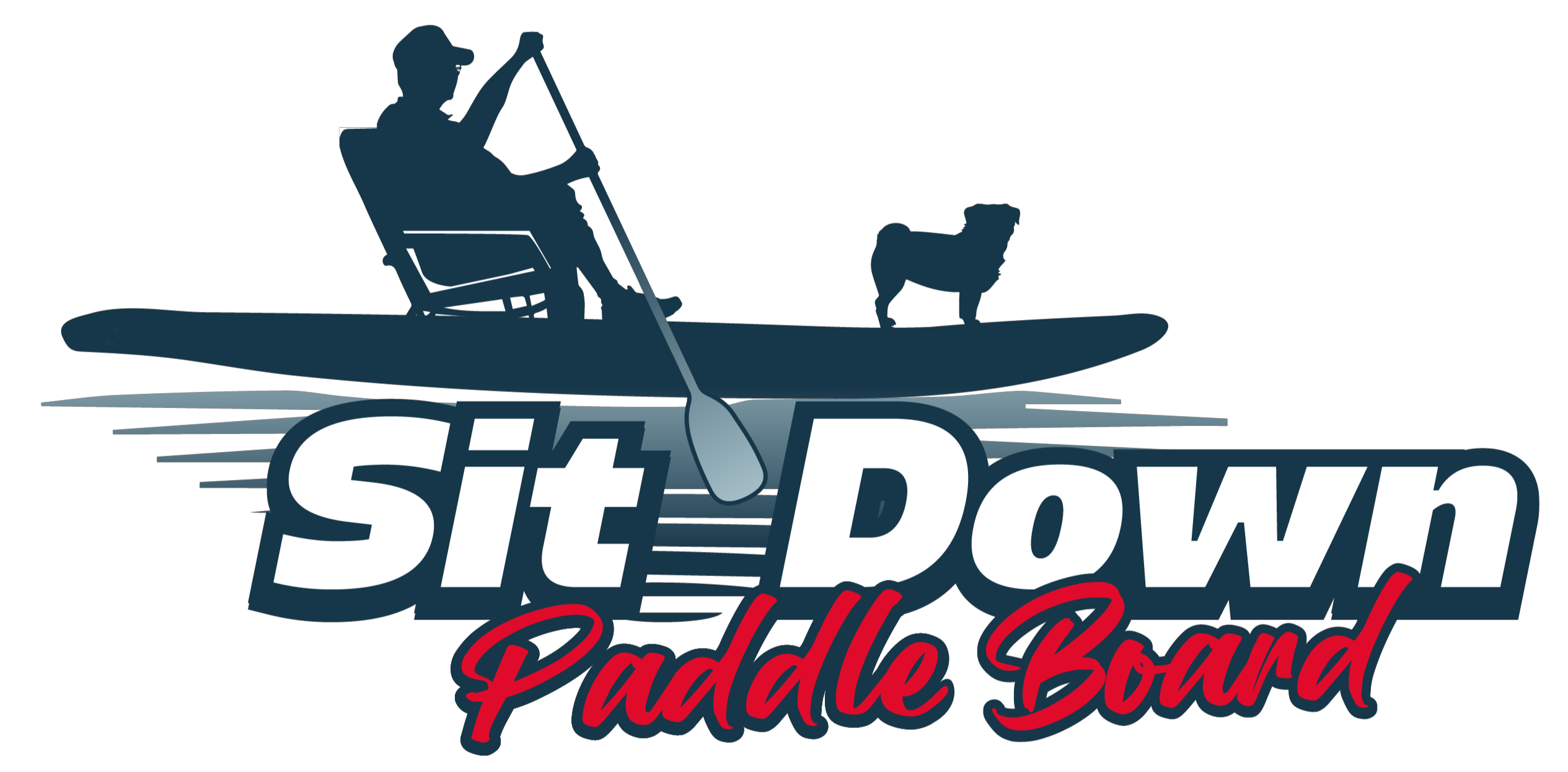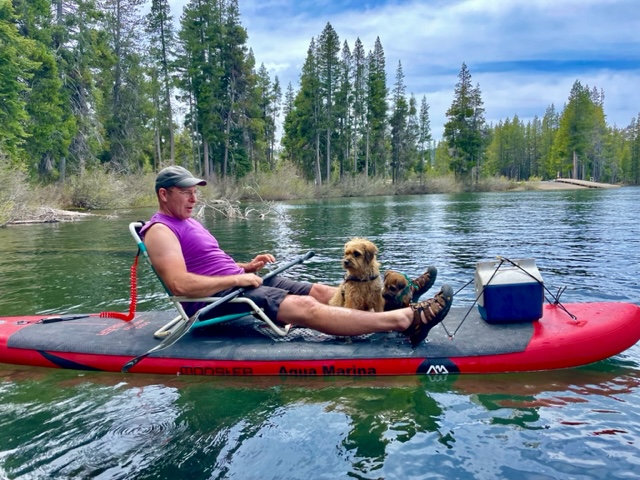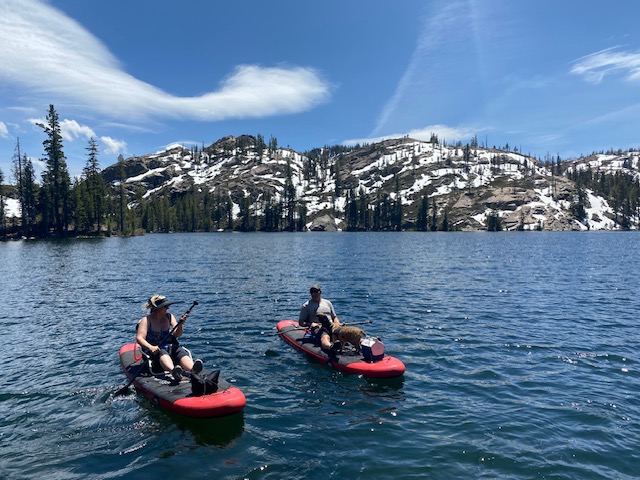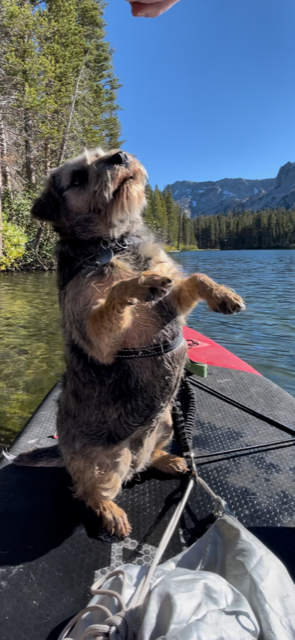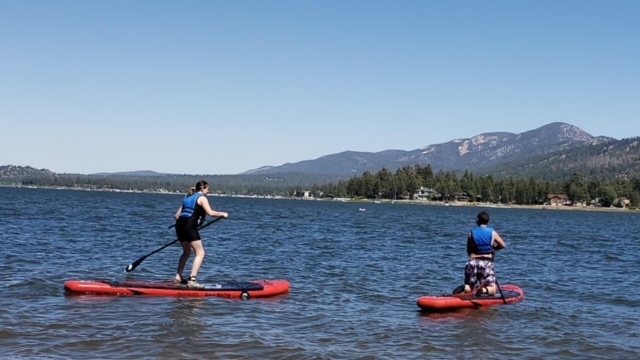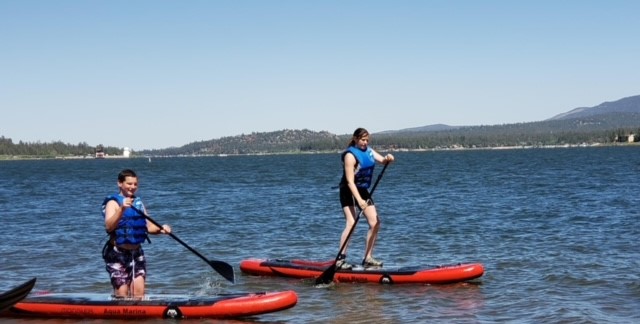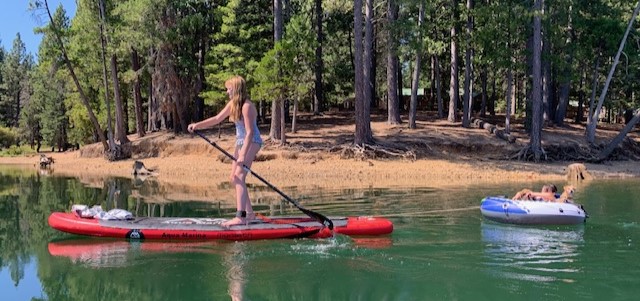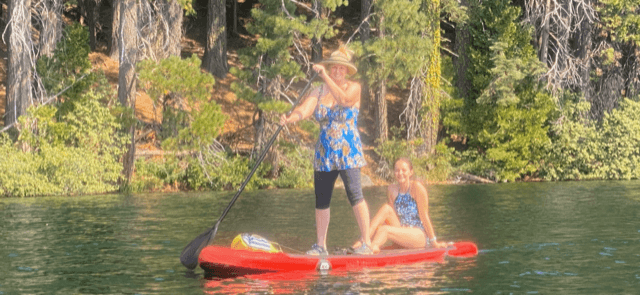How Hard is Paddle Boarding?
Many people ask the question, “How hard is paddle boarding?” The perception that it is hard prevents many people from taking up the sport. In reality, one of the great things about paddle boarding is that you can make it as easy or as challenging as you want. The key is to match up the kind of experience you want with the amount of energy you have and challenge you want.
Paddle boarding while seated comfortably on a folding chair on your board enjoying a sunny, windless day on a small, uncrowded lake is easy. Even my 85-year-old mother found her first paddle board under these conditions to be easy.
However, trying to stand up paddle board on the ocean when the water is crowded and there are big swells can be very challenging, even for experienced paddlers. The same goes for stand up paddle boarding into a strong headwind on a large reservoir with lots of boats driving around kicking up waves.
Then there are thousands of paddling scenarios that are somewhere between these examples that will affect how the question, “How hard is paddle boarding” should be answered.
First let’s talk about what conditions you should look for if you want to have an easy and fun day on the water.
6 Conditions that make paddle boarding easy and fun
People who ask, "How hard is paddle boarding?" are usually not envisioning the following 6 conditions that make paddle boarding super easy and fun. These six conditions are the best ones to start out with. After you get comfortable paddle boarding, there are so many different challenges and fun ways to paddle board that you can branch out into. A few of these include paddle board touring, paddle board fishing, tandem paddle board adventures and paddle boarding with your dog.
1. Calm Waters: Flat, still water makes paddle boarding more straightforward, especially for beginners. It provides a stable platform, which is easier to balance on, and allows individuals to concentrate on mastering the basics of paddle boarding.
2. Mild Weather: Warm, but not excessively hot weather, with a slight breeze, can make paddle boarding immensely enjoyable. It's more comfortable to be outdoors and in the water when the weather is mild. Seasoned paddle paddlers might not mind wearing neoprene booties or tights and an appropriate paddle jacket, but beginning paddlers will feel more relaxed on a warm day when a dip in the water would not be catastrophic.
3. Clear Skies: Sunshine and clear skies can significantly enhance the paddle boarding experience. Often wind will kick up on a cloudy day, especially in the afternoon. Paddle boarding into a head wind can be tough. Especially if you are standing. Sit down paddle boarding is much easier to do going into a head wind. We always bring our favorite paddle boarding seat with us, especially when we plan to tour around a big lake or reservoir. If a wind does kick up, we pull our seat out (if we haven’t already just because it is more relaxing) and continue our paddle while seated comfortably and only minimally affected by the wind.
Watch this video to see how easy it is to go from paddling standing up to sitting down comfortably on a seat and back again!
4. Low Traffic: Paddle boarding in a location that is free from excessive water traffic such as boats and jet skis can make the experience more relaxed and fun. Not only does boat traffic distract from the scenery, but boats create waves that can be intimidating to beginning paddlers who are learning to paddle standing up.
5. Gradual Slopes: If you're paddling in the sea, beaches with gradual slopes and no sudden drops help create smoother, more predictable waves which are safer and easier for paddle boarding. It is also easier to launch your paddle board as well as pull it out of the water and return to your vehicle if you aren’t dealing with steep hills.
6. The Right Paddle Board: Purchasing a paddle board that is both easy for you to transport while also both maneuverable and stable enough to make both stand up and sit down paddling fun is essential.
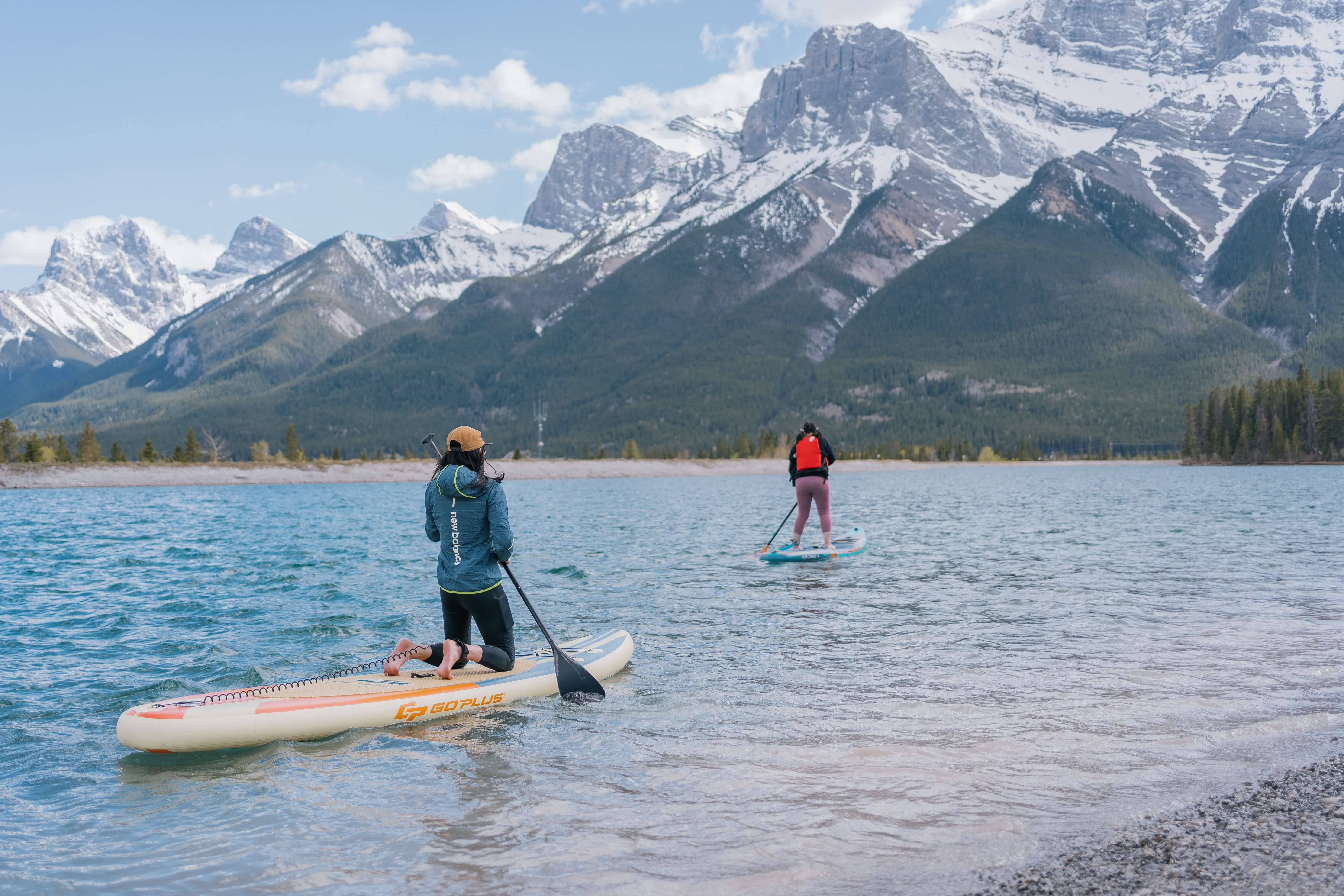 Having a nice day out paddle boarding in colder conditions but with the right equipment. credit: Mike Markov via Unsplash
Having a nice day out paddle boarding in colder conditions but with the right equipment. credit: Mike Markov via Unsplash6 Conditions that make paddle boarding hard
People who ask, "How hard is paddle boarding?" are usually worrying about at least one of the following conditions. Below are 5 Conditions that make paddle boarding hard and should be avoided by beginners or those that simply want to have a fun day. At their extreme, these are conditions that may be perfect for advanced paddle boarders who are training for races or otherwise enjoy challenging conditions to build their skills. For everyone else these are conditions that you will want to access before you put your board into the water to determine if they provide the right amount of challenge to make your day on the water fun. …or not!
1. Windy Conditions: Wind can push against the board, making steering and maintaining balance more challenging. Strong gusts can also cause you to tire more quickly. When the wind kicks up, we like to pull out our favorite folding seat and paddle comfortably seated. When the wind is really blowing, you can actually be going the opposite way that you are trying to paddle while standing since your body acts like a sail. When you sit down, it is like taking the sail down and it suddenly becomes much easier to make headway. We also like to stay close to the side of the lake when paddling into a head wind or wind coming from the side since the wind typically dies down near the shore.
2. Choppy Waters: Rough, choppy waters can make it especially difficult to keep balance on a paddle board. It requires much more physical effort and advanced skill to navigate. Again, if the water suddenly becomes choppy or boats start kicking up big waves, we simply sit down. We love our nice, comfortable folding chairs which allow us to feel very stable and without any worry about being tipped over due to boat wakes.
3. Cold Weather: Cold temperatures can make paddle boarding uncomfortable and potentially dangerous without the right gear. Hypothermia is a risk if you fall into cold water. We paddle in the early spring when there is snow surrounding the lake. The key is to be prepared and dress properly. If the water is cold and the air is warm, we simply stick close enough to the edge that we could swim if needed. If the water and the air are cold, we wear the appropriate booties, neoprene tights, wetsuit, paddle jacket, etc. Read all about our favorite paddle board accessories.
4. High Waves: Whether caused by wind or watercraft, high waves can constantly shift the board and require consistent corrections and quick reactions to stay upright.
Again, if wind or boats start kicking up big waves, we simply sit down. If we are at the beach and the waves kick up and make us nervous, we sit down. We love our nice, comfortable folding chairs which allow us to feel very stable, in control and reduce our worry about being tipped over due to waves.
5. Currents: Strong water currents can alter your course or make paddling strenuous. It is important, particularly for beginners, to be aware of the currents before setting out. If you are at the beach and paddling closer to shore you may run into a rip tide. Therefore, if you suddenly notice you are much farther from shore than you think you should be, keep paddling along the shore line and either your paddling or the current will carry you back in. Rivers can have strong currents as well. Again, walk or drive along the river you want to paddle on so you can be sure you know about any currents or rapids ahead of time. There are plenty of rivers with wonderful, smooth paddling conditions which are fun to explore. Usually you can tell if you are approaching an area with currents because the sounds of water hitting rocks will get louder.
6. The Wrong Paddle Board: When people ask, "How hard is paddle boarding?" they are often envisioning a board that is too unstable for them to be comfortable on. A paddle board that is too narrow and therefore too tippy or a paddle board that is too small and will not carry your weight or the weight of what you want to bring with you when you go paddling makes for a frustrating day paddling. The most common mistakes people make are:
- Buying a hard board when you don’t have a vehicle or rack to easily transport it
- Buying a board that is less than 31” wide or less than 10’6” long
- Buying a board that is less than 33” wide or less than 11’ long when you want to paddle with two people or with a dog and/or a cooler
Be sure that you don't get the wrong paddle board by doing some research. We found when we were getting our first paddle boards that most of the information out there was not helpful since it focused on people that treated paddle boarding as a serious sport instead of a fun recreational activity. While some people who paddle board recreationally may get serious and decide to race or wave surf, they may never have become interested in the serious sporting aspects unless they first started paddling recreationally. That is why we provide information that we hope beginning and intermediate recreational paddlers will find very useful.
- Read about the best paddle board for beginners
- Read about the best paddle boards for dogs
- Read about the best paddle boards with seats
 How hard is paddle boarding? Alot harder if you don't have the right board for how you want to paddle ...or do yoga!
How hard is paddle boarding? Alot harder if you don't have the right board for how you want to paddle ...or do yoga!What are the 5 hardest skills to master when it comes to paddle boarding?
When it comes to answering the question, “How hard is paddle boarding,” there is another dimension to consider as well. Some people asking this question may be wondering how hard it is to master the skills necessary to paddle board.
1. Balance: When people ask, "How hard is paddle boarding?" they are usually asking how hard is it to balance on a board in the water. One of the biggest challenges for beginners is learning to maintain balance on the board, especially in varying water conditions. This requires strong core muscles, focus, and practice. Balancing while standing up can be very difficult depending on the size of your board and the water conditions. At the same time, balancing on your board while seated in a kayak seat or folding chair is much easier because your center of gravity is closer to the board and you are very unlikely to lose your balance while sitting. We introduce all of our friends to sit down paddle boarding first. If someone has no prior paddling experience, it is much easier to learn the basic paddle strokes and how to maneuver the board while seated comfortably in a seat. Once you have the basics down then applying them while standing up and learning how to balance is much easier (and more fun in our opinion).
2. Paddle Technique: Proper paddling technique, including the timing and reach of your stroke, can greatly affect your speed, stability and steering. Understanding the correct body movements and positions is essential.
Watch Julie demonstrate the basic paddling strokes.
3. Steering & Turning: Mastering steering and turning techniques, especially in different water conditions, can be quite challenging. Perfecting maneuvers like the sweep turn, cross bow, or pivot turn takes both knowledge and practice.
4. Dealing with Weather Conditions: Wind and waves can significantly impact your ability to maintain control of the board. Learning how to handle these conditions and adjust your strategy accordingly can be difficult and requires experience. Developing the expertise to deal with changing weather conditions is something that paddlers master over time. That is why we suggest you begin on nice sunny days when there isn’t a lot of wind or boat traffic.
5. Endurance: Paddle boarding requires physical stamina, especially for longer rides. Building up the necessary endurance to paddle for extended periods takes time and regular training. Our favorite way to build endurance is to go paddle boarding for multiple hours, usually touring a lake. Not only do we like exploring, but with our seats on board, we can stand up and paddle for as long as if feels good and then when we get tired, we can sit down and still have fun exploring for much longer.
We have found that our standing balance muscles get tired way faster than our paddling muscles. Plus, when you are sitting down and not fighting to balance you don’t have to be constantly paddling. You can put your paddle on your lap and have a drink and a snack while floating along. This all adds up to more time on the water and ultimately better endurance.
Last thoughts regarding "How hard is paddle boarding?"
We hope we have succeeded in answering your question, “How hard it paddle boarding”. Now that you know that paddle boarding can be as easy and fun as you like while also as challenging and satisfying as you need to stay interested, we hope that you will at least give it a try.
We hope to see you out on the water!
